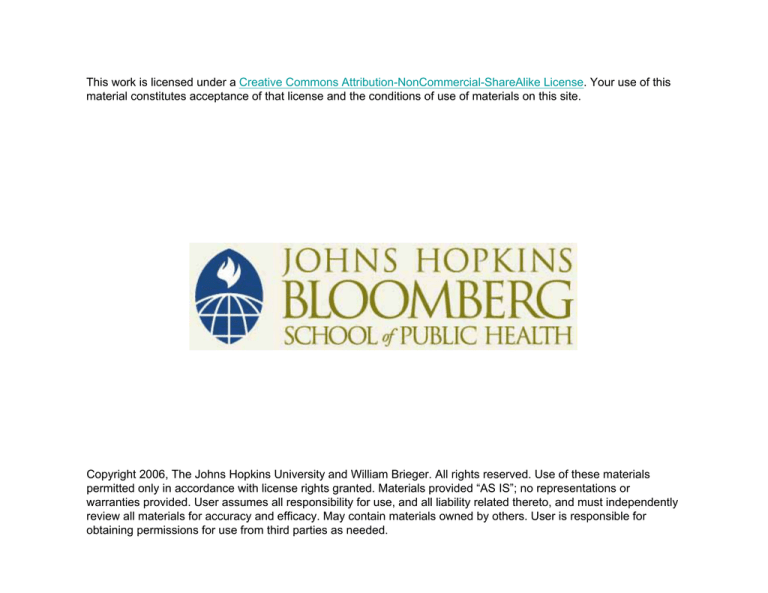
This work is licensed under a Creative Commons Attribution-NonCommercial-ShareAlike License. Your use of this
material constitutes acceptance of that license and the conditions of use of materials on this site.
Copyright 2006, The Johns Hopkins University and William Brieger. All rights reserved. Use of these materials
permitted only in accordance with license rights granted. Materials provided “AS IS”; no representations or
warranties provided. User assumes all responsibility for use, and all liability related thereto, and must independently
review all materials for accuracy and efficacy. May contain materials owned by others. User is responsible for
obtaining permissions for use from third parties as needed.
Evaluating Training Programs
William Brieger, MPH, CHES, DrPH
Johns Hopkins University
Section A
Overview and Definitions of Evaluation
Evaluation Defined
Evaluation is the comparison of an object of interest
against a standard of acceptability
In this case, the object of interest is the trainees’
performance or achievement of the tasks spelled out in
the training objectives
The standard of acceptability is also the level of
achievement specified in the objectives
Evaluation is an ongoing process
3
Accountability
According to Management Sciences for Health,
providing training to staff has many costs:
The resources involved in preparation, delivery
Travel and lodging for participants,
Staff time away from the workplace
4
Managers Need to Know
To justify these costs, managers need to feel confident
that the training will make a difference in staff
performance
That staff members have:
Not only acquired new knowledge, attitudes, and
skills from the training
But can, and do, put them into practice back on the
job
5
Types of Training Evaluation
Evaluation begins with
Needs assessments
Baseline evaluations
Input evaluations
And continues with
Process evaluation
Photo: USAID, The BASICS
6
Types of Evaluation
Outcome evaluations
(this module)
To assess new or
improved:
Knowledge,
Attitudes, and
Skills (KAS)
After training
Photo: USAID, The BASICS
Continued
7
Types of Evaluation
Impact evaluations of (next
module)
Job performance
Organizational
performance
Program performance
Demographic/health
indicators
Photo: USAID, The BASICS
8
Outcome Evaluation: What Are We Looking For?
Evidence that trainees have acquired new knowledge,
attitudes and skills (KAS)
Feedback from trainees on their perceived gains or gaps
9
What Else Are We Looking for?
Trainee impressions on
quality of sessions
Specific comments on
adequacy of all
arrangements
Logistics: Space,
facilities, time, comfort …
Presentation: level of comprehensibility,
appropriateness, challenge
10
Tools for Outcome Evaluation
Post-test questionnaire
Observation of trainee performance
Feedback forms
FGDs among participants
Meeting of training committee to:
Consider results of above and
Summation process evaluations
11
Section B
Pre- and Post-Tests
Pre- and Post-Tests
A pre-test can be planned as part of the activities during
the very first training session
Questions should be based on:
Diagnostic findings and training objectives
Such tests focus mainly on knowledge
The same test is repeated at the last session to determine
gains in knowledge
13
Types of Questions
Types of questions
include
Open-ended
questions
Multiple-choice
questions
Attitude/opinion
statements
14
Balance in Questions
Tests need to achieve a balance between
Covering the scope of training knowledge and
Being simple enough to complete in 30 minutes or
less
15
Open-Ended Questions
Examples
List all the ingredients that can be mixed together
for a homemade solution for oral rehydration
Describe the danger signs of dehydration
Mention the steps for making homemade ORS
Open-ended interviews are useful for low literacy
trainees
16
Multiple-Choice Questions
From the list, check all
the items that can be
mixed together for a
homemade solution for
oral rehydration
Sugar
Soft drink
Salt
Vegetables
Water
17
Attitude Items at Pre-Test
Agree
Uncertain
Mothers can be trusted to mix
ORS at home
It is best for the mother to
bring a child with diarrhea to
the clinic for management
3
3
It is inconvenient to teach
mothers at clinic to manage
diarrhea
Telling mothers how to make
ORS is adequate to ensure
they know what to do
Disagree
3
3
18
Patent Medicine Vendor Training in Nigeria
Knowledge scores
PMV Training committee
was formed
PMVs requested lessons
on common illnesses and
skills such as reading a
prescription
Either clerk or owner
attended, not both
Pre/post test enhanced by using control
19
Ensuring There Was Really a Gain
The two sets of PMVs were not identical
33 took pre-test, 37 took post-test
A paired t-test was calculated for the 28 individuals who
took both tests
Their pre-test (46.0%) and post-test (70.8%) scores
showed the significant gain at post-test
t = 12.161, p < 0.001
Thus a need for identifiers to match tests
20
PMV Training in Kenya: Quality Assurance Project
Goal: To equip PMVs with
customized job aids to
communicate new malaria
guidelines to private drug
outlets
All were taught to educate
customers and train other
PMVs on malaria
recognition and prompt
treatment
21
Testing Specific Areas of Knowledge
Specific Malaria Knowledge, by Intervention Status
Intervention Control
Total
(n=101)
(n=151) (n=252)
Fever is main symptom of malaria
94.1
94.7
94.4
Fansidar is more effective than other drugs
92.1
85.4
88.1
Fansidar is not too strong for children *
69.3
47.4
56.3
Fansidar and panadol is correct treatment *
88.1
64.2
73.8
Fansidar is a single dose treatment *
83.2
64.9
72.2
Fansidar can be sold in shops *
76.2
43.7
56.7
Continue feeding child with malaria
95.0
90.1
92.1
Don’t sell another drug if child gets worse *
91.1
71.5
79.4
Don’t always sell what is demanded *
87.1
65.6
74.2
Shouldn’t sell smaller doses of drug *
95.0
82.8
87.7
Main Malaria Messages
*
Significant at p<.01
22
Trainees Respond Differently
23
Teacher Training for Visual Acuity Testing
Ibadan, Nigeria
17-point knowledge test
What structure of
the eye is
responsible for
image formation?
What are three
common causes
of blindness
Name two ways
of detecting visual
problems in pupils
24
Health Worker Attitude Changes
CDT in onchocerciasis control
Attitude statements
Communities are quite capable of managing the
distribution of ivermectin
Onchocerciasis control should be best run by the
district (as opposed to state or national levels)
25
More Attitudes Statements
Community involvement in ivermectin distribution saves
the time of the health worker for doing other things
Health workers in this community cannot handle
ivermectin distribution because they are over-worked
Health workers do not believe that community-directed
distribution of ivermectin is the best way to make
ivermectin available to the people
26
Health Worker Attitudes Change
20
mean attitude score
15
10
5
0
Pre-Test
Post-Regular
Post-Enhanced
-5
-10
Group/Time
27
Teachers Self-Efficacy for Testing Visual Acuity
Very
Capable
Recognizing a child with
visual problems
Capable
Not
Capable
3
Using a visual acuity
chart
3
Interpreting chart/test
results
Knowing when to make
a referral
Unsure
3
3
28
Changes in Self-Efficacy Scores
One often expects
knowledge gains in both
groups
Exposure to testing
procedures creates some
knowledge
In this case exposure to
skill test at pretest
decreased control
teachers confidence
29
Tests: A Summary
Pre-/post-tests document knowledge gains
Matching results insures that individuals actually had
significant gains or not
Using a control (e.g., people coming for a future round of
training) ensures effect was due to program
Continued
30
Tests: A Summary
Looking at individual
questions/sections helps
identify problem areas
Finally, comparisons are
needed by trainee
background
31
Section C
Observation, Feedback, and Analysis
Observation Checklists
When we were developing training objectives, we
mentioned the words:
Behavior, observable, measurable
A checklist enables us to observe and measure trainee
behavior
The checklist spells out the specific steps or tasks one
would expect the trainee to perform at the end of the
program
33
Patient Counseling Checklist
Fully
Establish a cordial relationship
with the client through
greetings and introductions
Not Done
3
Uses open-ended
interviewing to encourage the
client to speak fully for
him/herself
Practices active listening; is
attentive and does not
interrupt
Partially
3
3
34
Training Primary School Teachers to Test Visual Acuity
Materials and instructions were provided
On the table is a Snellen visual acuity chart, an
opaque cover, a frame inserted with + 1.00 power
lenses, and a meter rule
Please assess the visual acuity of these pupils at an
appropriate distance giving clear and audible
instructions
35
Test Instructions and Results
Record your findings
Make an
assessment on the
state of each
child's visual
acuity and ocular
condition on the
sheet of paper
provided
There were eight
steps
36
Feedback Forms
In addition to obtaining information on trainee
knowledge and skills, trainers can obtain feedback on
satisfaction with the quality of the program
Trainees can rate aspects of the program on one-page
forms, as seen in the next slide
These forms are filled out anonymously
37
Simple Feedback Forms
Check the column that best shows your
opinion of the program (1=never; 5=often)
1 2 3 4 5
1. I feel that I will be able to use what I
learned
3
2. The program was presented in an
interesting manner
3
3. The training facilities met my needs
4. The program covered the promised
objectives
5. The trainers encouraged participation
and questions
3
3
3
38
Plus Open-Ended Questions
What did you find most
useful in the program?
What did you find least
useful?
What suggestions do you
have for improving the
program?
39
Focus Group Discussions (FGDs)
FGDs not only provide feedback to the trainers, but also
allow the trainees to integrate their experiences
FGDs should have no more than six members
These should be scheduled toward the end, possibly
over lunch
The room or space used should offer privacy
40
Using FGDs
One valuable use of the
FGD method is to bring
together trainees who
observers thought were too
quiet during sessions
This would give them a
chance to air their views
and provide evidence of
learning
41
Value of FGDs
FGDs offer an
opportunity to think
about the future
application of
knowledge and skills
gained
Photo by Kabiru Salami
42
In FGDs, Think about “Back on the Job”
It is not enough to
document that trainees
have acquired new KAS
before they leave
Silberman suggests trainees
consider how they will
apply the new KAS when
they return
43
Back on the Job
This discussion is an evaluation of the practicality and
feasibility of the new KAS
And a way to learn problem-solving skills
Engaging in realistic discussion identifies obstacles for
applying new knowledge and implementing new skills
44
Planning for “Back Home”
Developing action plans
based on these discussions
helps one apply new KAS
Including a plan to
monitor oneself
This will prevent
disappointment when
enthusiastic returned
trainees meet a wall of
indifference or jealousy
45
Having the Tools
Training needs to equip
people with skills,
knowledge, attitudes
This may not be enough
VHW trainees are given
drug boxes so that they can
start work immediately
46
Finally, Use Test Results and Feedback
Training committee should
summarize results as soon
as possible
Identify gaps that need
attention during follow-up
visits and correspondence
Improve the design of the
next program
Copyright 2005, Bill Brieger and The Johns Hopkins University. All rights reserved. Use of these materials
permitted only in accordance with license rights granted. Materials provided “AS IS”; no representations or
warranties provided. User assumes all responsibility for use, and all liability related thereto, and must
independently review all materials for accuracy and efficacy. May contain materials owned by others. User
is responsible for obtaining permissions for use from third parties as needed. Unless otherwise stated, all
photos are the property of Bill Brieger.
47





